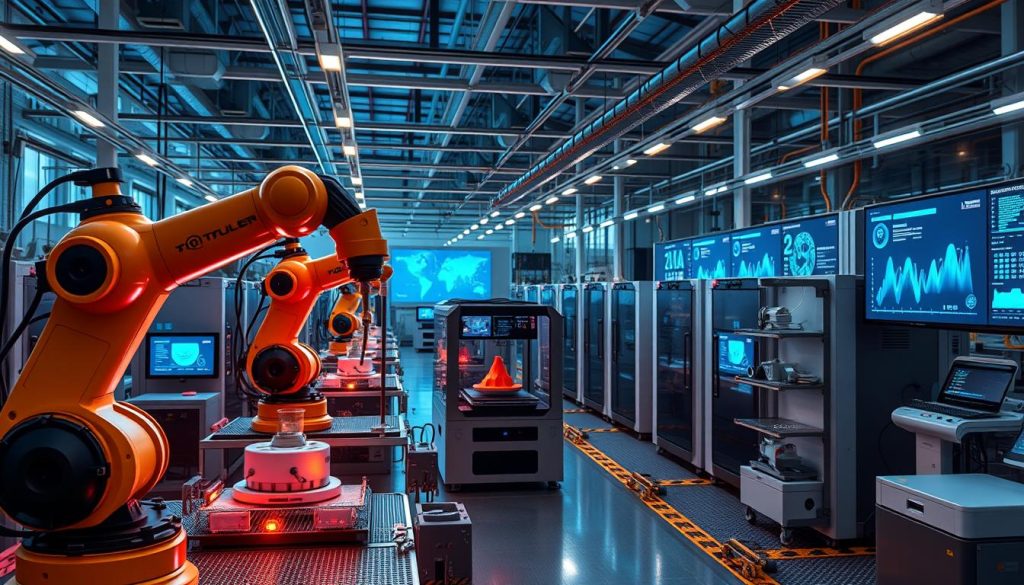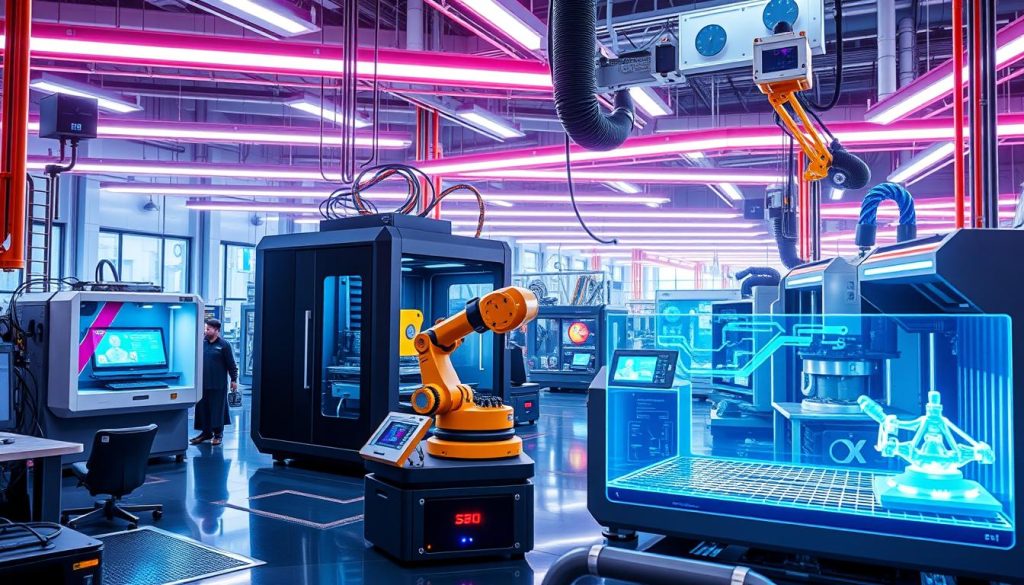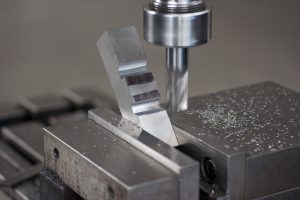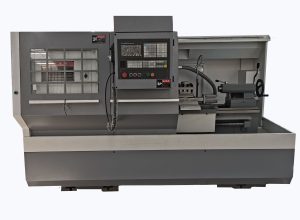The world of manufacturing is changing fast, thanks to digital manufacturing. This guide will cover the basics of digital manufacturing. We’ll see how new technologies are changing how things are made in many industries.
So, what is digital manufacturing, and how is it changing the future of making things? Also, how can businesses use these digital tools to stay ahead? Let’s dive into the world of digital manufacturing and its big impact on industry.
What is Digital Manufacturing?
Digital manufacturing uses digital technologies to change how we make things. It combines computer-aided design (CAD) and computer-aided manufacturing (CAM) with data analytics and cloud computing. This makes production more efficient, flexible, and innovative.
Definition and Key Concepts
Digital manufacturing blends digital tools into every part of making things, from design to production. It helps companies make better use of resources, cut down on waste, and make products that fit individual needs. With digital transformation tools, businesses can make their processes smoother, make better choices, and keep up with the fast-changing world of manufacturing.
How Digital Tools Revolutionize Manufacturing Processes
Digital technologies have changed how we make things. CAD and CAM systems let designers and engineers work faster and more accurately. Data analytics and cloud computing give insights in real-time, helping companies make smart choices and adapt to market shifts.

These digital tools help manufacturers work better, make products that fit exactly what customers want, and get products to market faster. By using digital transformation, companies can make their production smoother, waste less, and create new products that meet changing customer needs.
Benefits of Digital Manufacturing
Digital manufacturing brings many benefits to businesses. It leads to productivity gains, better quality control, and more lean manufacturing. Advanced technologies help companies make their production smoother, improve product quality, and introduce new products quickly.
Improved Efficiency and Accuracy
Digital tools like computer-aided design (CAD) and additive manufacturing make workflows better. Rapid tooling methods speed up prototyping and production. This means products hit the market faster, saving time and resources.
Enhanced Customization and Flexibility
Digital manufacturing lets businesses offer more customization and personalization. Additive manufacturing and computer-aided technologies make it easy to meet changing market needs. Companies can quickly provide tailored solutions.
Reduced Time-to-Market and Costs
Digital manufacturing’s streamlined processes and waste reduction mean reduced time-to-market and lower costs. Manufacturers can quickly meet customer needs, stay ahead in trends, and keep a competitive edge.
“Embracing digital manufacturing has been a game-changer for our business. We’ve seen significant improvements in productivity, quality, and our ability to adapt to customer demands.”
– Jane Doe, Manufacturing Manager
Key Technologies in Digital Manufacturing
Digital manufacturing has grown thanks to new technologies. These tools change how we design, make, and improve products. They bring efficiency, customization, and sustainability to the manufacturing world.
3D Printing and Additive Manufacturing
3D printing leads the way in digital manufacturing. It makes complex, custom parts fast and accurately. This method builds objects layer by layer, speeding up design changes and reducing waste.
Robotics and Automation Systems
Robots and automation are key in digital manufacturing. They use artificial intelligence (AI) and machine learning to improve production. This makes work more efficient and lets people focus on important tasks.
Digital Twins and Simulation Software
Digital twins are also important. They are virtual copies of products or processes. With Internet of Things (IoT) sensors and data, they help test and improve operations without stopping production. This leads to better maintenance, forecasting, and process improvements.
These technologies, along with data-driven decisions, are changing manufacturing. 3D printing, robotics, and digital twins bring efficiency, flexibility, and innovation to the table.

Applications of Digital Manufacturing
Digital manufacturing is changing the game for industries worldwide. It uses advanced tech to speed up making prototypes, produce in large quantities, and make manufacturing greener. This includes better supply chain management and CNC machining solutions. It’s ushering in a new age of innovation and competition.
Prototyping and Product Development
Technologies like 3D printing have changed how we develop products. Now, companies can make top-notch prototypes and test designs fast. This quickens the time to market and allows for more customization.
This speed helps businesses meet changing customer needs quickly. It keeps them ahead of rivals.
Mass Production with Reduced Waste
Digital manufacturing is also changing how we make things in big quantities. Automation, robotics, and smart software are making production more efficient, accurate, and green. By improving supply chains and using sustainable manufacturing and Industry 4.0 implementation, companies cut waste and boost their global competitiveness.





